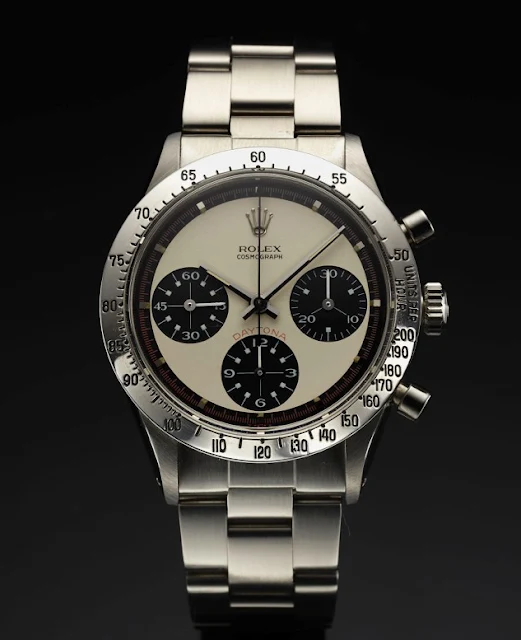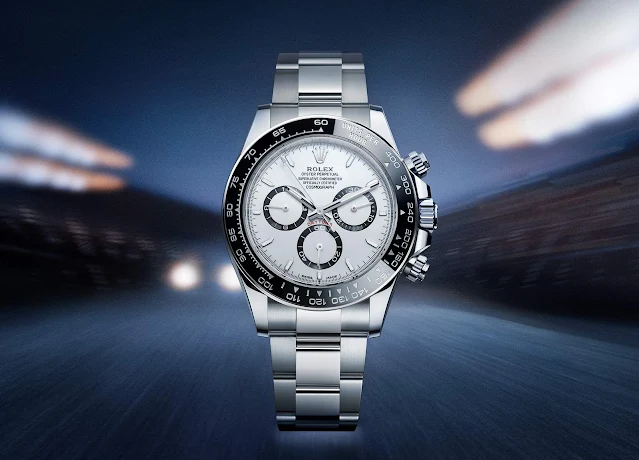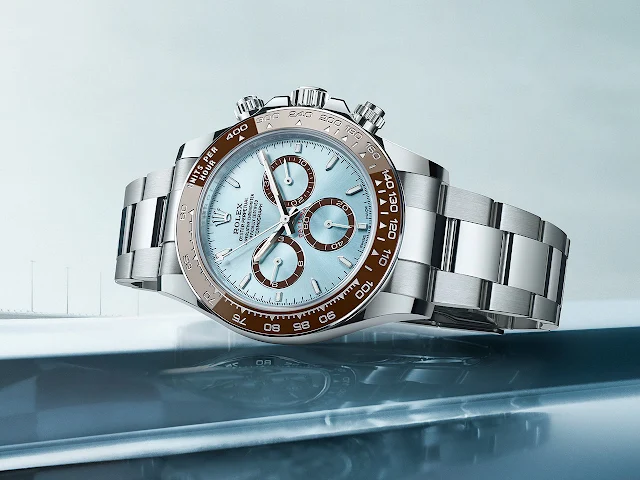Daytona is the name of a Florida city which, at the beginning of last century, started attracting motorsport enthusiasts for its wide beach of smooth, compacted sand, ideal for land speed record attempts.
In 1936, the first stock car race was held on the Daytona Beach Road Course which was then replaced in 1958 when the National Association for Stock Car Auto Racing (NASCAR) created the Daytona International Speedway, the home of the Daytona 500, the most prestigious race in NASCAR. With its his banked design, the Daytona International Speedway permitted higher speeds and gave fans a better view of the cars.
Daytona became the world capital of speed.
Since the 1930s Rolex had started to build a strong reputation as a manufacturer of versatile sport watches thanks to its 'sealed against the elements' Oyster case and famous testimonials like Sir Malcom Campbell, which can be somehow considered the first Ambassador of the brand. In those years, Rolex produced its first chronograph wristwatch with a single push buttons on the side to start, stop and reset a separate second hand. For these chronograph models Rolex adopted movements from the company Valjoux.
But it was in 1955 that Rolex introduced a manual-wind chronograph in an oyster case which can be considered a precursor of the Daytona. The Rolex Oyster Chronograph reference 6234 featured a tachometer scale on the outer ring and a telemeter scale for distances on the inner ring. From 1955 to 1961, Rolex produced about 2300 stainless steel pieces and less than 150 in 14k or 18k gold in a variety of black and white dials. The three sub dials (small seconds at 9 o'clock, 30 minutes and 12 hours counters respectively at 3 and 6 o'clock) had different sizes in the various versions.
One of the first Rolex Oyster Chronograph ref. 6234 with tachometer and telemeter scales
A Rolex Oyster Chronograph ref. 6234 with black dial and baton indexes
Pre-Daytona Rolex Chronograph ref. 6238 with black dial: note the applied steel baton indexes with luminous dots and the luminous steel baton hands
Pre-Daytona ”George Lazenby“ Rolex Chronograph ref. 6238: a model like this was worn by the Australian actor during agent 007’s mission at the Piz Gloria (Murren, Switzerland) - 1964
Calibre 722
The ref. 6238 was not yet an ‘Oyster’ model and did not have a screw-down crown or buttons.
In 1963 Rolex introduced the first Cosmograph model, the reference 6239, without replacing reference 6238 which remained in production until 1967. The distinctive characteristic of reference 6239 was the tachometer scale engraved on the metal bezel to enhance the legibility of the dial, available in black with silver counters or in silver with black counters. In the first years of production the bezel was graduated up to 300 units per hour to change later to 200 units per hour.
A 1963 Rolex Cosmograph ref. 6239 with silver dial and black counters
- an outer track, matching the sub-dials, runs around the edge of the dial;
- sub-dials with cross-hairs meeting at centre and block markers instead of lines;
- the seconds sub-dial placed at 9 o'clock is marked at 15, 30, 45 and 60, instead of being marked at 20, 40 and 60 as in the standard models.
Rolex Cosmograph Daytona ref. 6239 - 1968
Rolex Cosmograph Daytona ref. 6239 - 1968
Anyhow, the Daytona name was not always on the dial in the following reference 6240, a totally waterproof chronograph equipped for the first time with screw down push-pieces. This model also introduced a new metal bezel with black plastic insert and white numerals. Still with a diameter of 37 mm, the reference 6240 was produced until 1969 in stainless steel only. The Oyster name appeared between Rolex and Cosmograph. Ref. 6240 models are among the rarest Daytona ever produced.
Rolex Cosmograph Daytona ref. 6240 introducing screw-down buttons and black plastic bezel
In this reference 6240 model, the Daytona name does not appear on the dial
Extremely rare ref. 6240 with an unusual dial bearing the word Rolex only - circa 1965
Between 1970 and 1971 Rolex introduced four new Cosmograph Daytona references fitted with the new calibre 727 housed in a 37 mm case.
Calibre 727
References 6262 and 6264 adopted push-down buttons with metal bezel (ref. 6262) or black plastic bezel (ref. 6264). These references were manufactured from 1970 to 1972. Dials were white or black with sub-dials in contrast.
Reference 6262 with metal bezel (note the rare blue Daytona name on the model on the right)
Reference 6264 with black plastic bezel (in this case with exotic dials)
An attractive Daytona reference 6263 produced in 1978 - Courtesy of Bob's Watches
Reference 6263 models: in steel with black dial (above) and in 14k yellow gold with exotic dial (below)
Reference 6265: a standard steel model with black dial (above) and a red dial prototype made in 1979 in few examples (below)
His very first Rolex Daytona was a ref. 6263 with black dial and white sub-dials (a standard dial, not an exotic one).
When he started his race car driver career in 1972, his wife Joanne Woodward gifted him with a rare and exclusive version of the Cosmograph Daytona – a reference 6239 fitted with what the brand called an “exotic” dial.
That same year he was also photographed with the watch on his wrist in a famous picture that will be later featured in the Rolex-sponsored photographic book "Paul Newman - Les images d'une vie" by Pierre-Henri Verlhac and Yann-Brice Dherbier, Phyb Editions. Newman is here wearing his Daytona on a leather military strap, for many years his favourite option.
Photo of Paul Newman courtesy of Douglas Kirkland/ Corbis Via Getty Images
The Daytona reference 6239 owned and worn by Paul Newman - Courtesy of Phillips Watches
The Paul Newman Daytonas are today among the most sought after models by Rolex collectors.
In 2013, during a special Rolex themed auction held in Geneva, Christie's sold a rare Daytona Ref. 6263 in steel, manufactured in 1969, for the amount of 989,000 Swiss Francs (approx 1,089,186 US Dollars). The watch remained dormant in the Swiss retailer's vault for years, before being sold in 1978.
The first Daytona to sell for more than US$ 1,000,000
Three years later, Philipps Watches sold a rare Cosmograph Daytona "Paul Newman Oyster Sotto" reference 6263, stamped inside caseback 6239, produced in 1969, for Swiss Francs 1,985,500 (the estimate was Swiss Francs 750,000 - 1,500,000). The Italian nickname of "Oyster Sotto" for the dial, translating to "Oyster Underneath", was due to the placement of the "Oyster" designation beneath the word "Cosmograph" at 12 o’clock.
All these records were smashed on 26 October 2017 at an auction in New York, when Phillips Watches offered for sale the “Paul Newman” Cosmograph Daytona model owned and worn by none other than Paul Newman. After 12 minutes of bidding, the watch was sold for the incredible amount of US$ 17,752,500 / Swiss Francs 17,709,894 / Euro15,228,095, establishing a world record as the most expensive wristwatch ever sold at an auction. The record lasted until November 9, 2019 when the one-off Patek Philippe Grandmaster Chime ref. 6300A-010 sold for the amount of US$ 31,194,170 / Swiss Francs 31,000,000 / Euro 28,200,700 at the Only Watch charity auction. You can read more about the story of this exceptional Daytona watch reading our dedicated article here.
Another picture of the Daytona owned and worn by Paul Newman which, at the end of 2017, was sold by Phillips Watches New York for the amount of US$ 17,752,500 - Courtesy of Phillips Watches
In 1984 Rolex produced few examples of Cosmograph Daytona with gold cases and diamond set dials and bezel (ref. 6269 with brilliant cut and ref. 6270 with baguette cut).
A breakthrough year was 1988, when Rolex started manufacturing a brand new Oyster Perpetual Cosmograph Daytona, the reference 16500 series. The new chronograph was available in three versions: in steel (ref. 16520), in steel and gold (ref. 16523), and in gold (ref. 16528). There were several novelties compared to previous models. The case diameter increased from 37 mm to 40 mm and a sapphire crystal replaced the Plexiglas. Available in white or black, the dial was lacquered with metal hour indexes inlaid with luminous material and sub-dials with scales in contrasting colours (silver for the black dial and black for the white one). The Daytona was now available only with screw-down push-pieces.
Reference 16520, black and white dials
Calibre 4030
In 1991 Rolex produced a special series of just 10 examples of Reference 16528 in yellow gold with a a galvanised blue dial with soleil details and a bezel graduated to 400 units per hour. This version is often referred to as the Chairman Daytona because it was intended to be a gift for top Rolex directors.
The Chairman Daytona with blue galvanised dial
Other variations were created, including two models with leather straps (ref 16518 in yellow gold and ref. 16519 in white gold), and various jewel versions featuring bezels or dials set with diamonds and other precious stones.
In the meanwhile, Rolex had started working on a new, entirely in-house developed movement - the Calibre 4130 - incorporating just 290 components, far fewer than a standard chronograph, making it much easier to service. Beating at 28,800 A/h like its predecessor, the new movement increased the power reserve from 54 to 72 hours and introduced a stop-seconds function together with Rolex own’s spiral balance-spring.
The new Rolex Daytona Cosmograph collection, housing the Calibre 4130, was finally launched during the Baselworld exhibition in the month of March 2000. All the new models of the new 116500 series had a diameter of 40 mm and were slightly thinner of the previous versions.
The adoption of the new Calibre 4130 resulted in some dial changes. In particular, the small seconds counter was moved at 6 o'clock inverting its position with the chronograph hour counter. The subdials at 3 and 9 o'clock were moved slightly up. Larger hands and hour markers improved readability, especially in the dark.
The bracelet and the clasp were also improved by introducing a much more solid construction while maintaining the Flip-Lock safety clasp first used in 1994. The new clasp introduced an Easy Link hidden inside the clasp, useful to quickly adjust the size of the bracelet.
Reference 116520, in stainless steel with white or black dial, was still the most sought after model although its production was not constrained anymore by the limited availability of the movements as it happened for the reference 16520 with its El Primero-based Calibre 4030.
Other versions of the 116500 line included: ref. 116523 in stainless steel and gold (2000), ref. 116528 in yellow gold (2000), ref. 116509 in white gold with a new graduated bezel with numerals orientated towards the centre with black or white dial (2004), ref. 116505 in Everose gold, a special pink gold alloy created by Rolex (2008).
In 2011 Rolex launched the Daytona reference 116515 in a pink gold case with a monobloc ceramic bezel and ivory or chocolate dial. The same ceramic bezel, combined with an unusual ice blued dial with chestnut brown lacquer counters, was used in 2013 for the Daytona Cosmograph Platinum, the model created by Rolex to commemorate fifty years from the launch of its most celebrated watch.
Calibre 4130
The new Rolex Daytona Cosmograph collection, housing the Calibre 4130, was finally launched during the Baselworld exhibition in the month of March 2000. All the new models of the new 116500 series had a diameter of 40 mm and were slightly thinner of the previous versions.
The adoption of the new Calibre 4130 resulted in some dial changes. In particular, the small seconds counter was moved at 6 o'clock inverting its position with the chronograph hour counter. The subdials at 3 and 9 o'clock were moved slightly up. Larger hands and hour markers improved readability, especially in the dark.
Dial comparison: reference 16520 vs 116520
The micro-etched Rolex crown on the sapphire crystal at 6 o'clock, not visible to the naked eye
The bracelet and the clasp were also improved by introducing a much more solid construction while maintaining the Flip-Lock safety clasp first used in 1994. The new clasp introduced an Easy Link hidden inside the clasp, useful to quickly adjust the size of the bracelet.
Other versions of the 116500 line included: ref. 116523 in stainless steel and gold (2000), ref. 116528 in yellow gold (2000), ref. 116509 in white gold with a new graduated bezel with numerals orientated towards the centre with black or white dial (2004), ref. 116505 in Everose gold, a special pink gold alloy created by Rolex (2008).
Rolex advertising for the Daytona 116509 in white gold with meteorite dial, roman numerals and a new graduated bezel - 2004
Rolex advertising for the Daytona 116505 in Everose pink gold - 2008
In 2011 Rolex launched the Daytona reference 116515 in a pink gold case with a monobloc ceramic bezel and ivory or chocolate dial. The same ceramic bezel, combined with an unusual ice blued dial with chestnut brown lacquer counters, was used in 2013 for the Daytona Cosmograph Platinum, the model created by Rolex to commemorate fifty years from the launch of its most celebrated watch.
In 2023 Rolex celebrated the 60th anniversary of the Daytona by presenting its new-generation Daytona, updated across the entire range, including the iconic version in stainless steel identified by the new reference number 126500 LN.
Compared to the previous generation, the new model introduced an updated ceramic Cerachrom bezel with the edge made in the same metal as the case. The dial received new graphic balance, with slimmer hour markers and colour combinations that accentuate the contrast between the dial and the counters – or their rings. The lugs also went through a restyling.
The new movement, calibre 4131, is an evolution of calibre 4130, and incorporates a number of the major innovations that Rolex has brought to its movements, including the Chronergy escapement. For more details, you can read our overview of the Rolex Daytona 2023 collection.
After 60 years, the Rolex Daytona's legacy continues to shine bright, a testament to its timeless design and enduring appeal.
By Alessandro Mazzardo.
Latest revision June 1, 2024.
© Time and Watches. All Rights Reserved. Copying this material for use on other web sites or other digital and printed support without the written permission of Time and Watches or the copyright holder is illegal.
- Read about other iconic watches.
Latest revision June 1, 2024.
© Time and Watches. All Rights Reserved. Copying this material for use on other web sites or other digital and printed support without the written permission of Time and Watches or the copyright holder is illegal.
- Read about other iconic watches.



















































